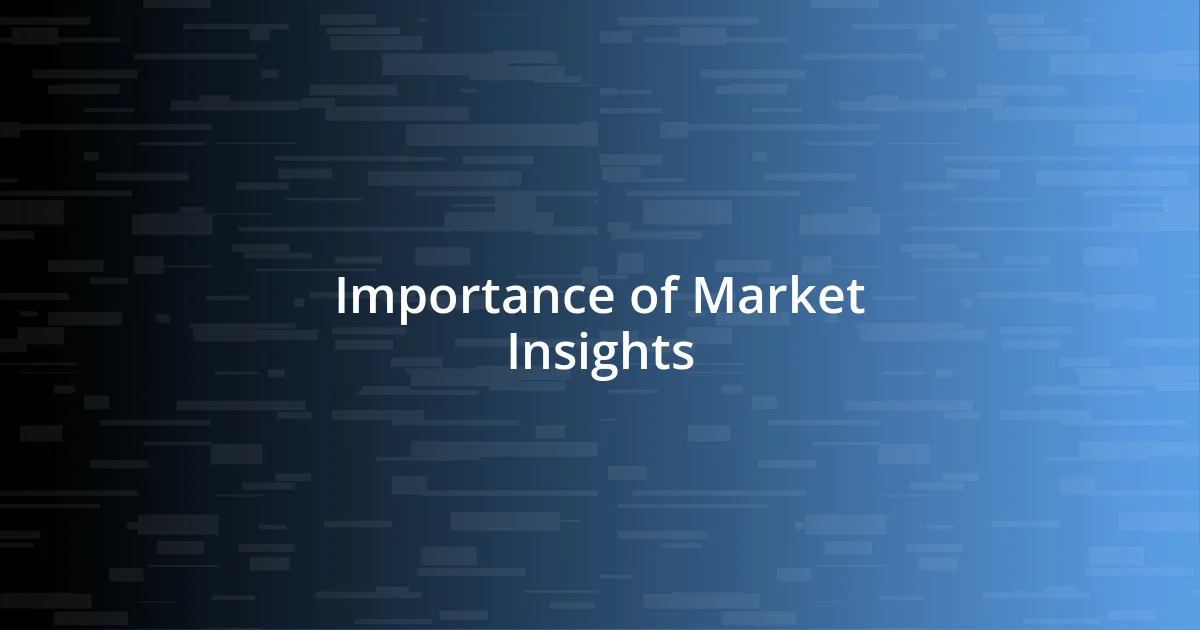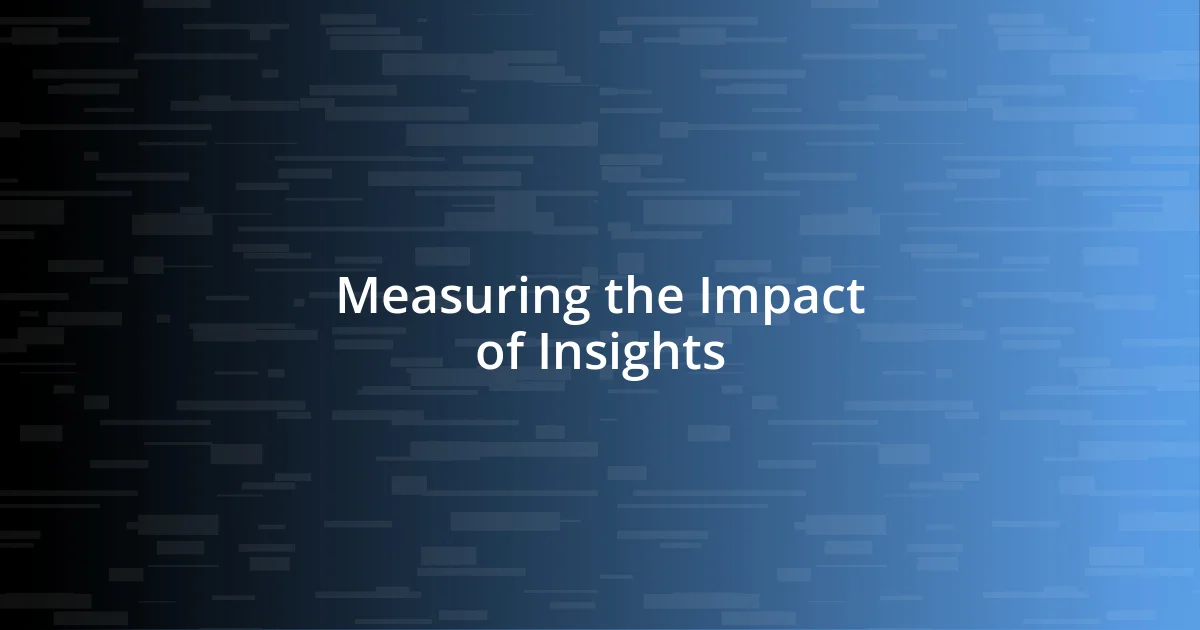Key takeaways:
- Utilizing market research tools like surveys and focus groups yields invaluable insights that inform product development and marketing strategies.
- Applying insights from consumer feedback can lead to significant improvements and align offerings with actual customer needs, fostering satisfaction and loyalty.
- Measuring the impact of insights through clear KPIs and storytelling enhances understanding of data and its real-world implications, promoting a culture of collaboration and shared ownership.

Understanding Market Research Tools
Market research tools are the backbone of understanding consumer behavior and market trends. I remember the first time I used a survey tool; the flood of insights I received transformed my approach to product development. It’s like having a conversation with your audience, discovering what truly matters to them. Can you imagine making decisions without having that kind of direct feedback?
There are various types of tools available, each serving different needs. For instance, I often rely on analytical software to track online engagement. It’s fascinating how data can tell a story, revealing patterns that sometimes aren’t so obvious at first glance. This deep dive into analytics makes you wonder: how often do we overlook crucial details in our strategic decisions?
When I first encountered focus groups, I was surprised by the richness of qualitative data they provide. Listening to people share their opinions can evoke strong emotions, enlightening you about preferences you might never have considered. Have you ever experienced that “aha!” moment during a discussion that changed your perspective? Those insights can truly reshape your marketing strategy in ways you wouldn’t expect.

Importance of Market Insights
Understanding the importance of market insights can’t be overstated. When I first analyzed consumer preferences, the data revealed unexpected opportunities that had previously gone unnoticed. Knowing what your audience thinks and feels allows you to tailor your offerings, aligning them with real-world needs.
In my experience, leveraging market insights has often determined a product’s success or failure. For example, I remember how a simple shift based on customer feedback improved our user satisfaction ratings significantly. It’s like adjusting a recipe; a pinch of salt can enhance flavors, just as small adjustments in marketing can lead to better outcomes.
Moreover, market insights serve as a compass, guiding strategic decisions. I once faced a dilemma about entering a new market, but thorough research unveiled potential challenges I hadn’t considered. This insight armed me with the knowledge to navigate the landscape effectively, ensuring a smoother launch.
| Key Benefits | Description |
|---|---|
| Consumer Alignment | Understanding what customers need and want allows for more relevant product offerings. |
| Risk Mitigation | Informed decisions based on insights help identify potential risks before they become significant issues. |

Types of Market Research Tools
When it comes to market research tools, I’ve encountered several types that cater to specific aspects of data gathering and analysis. One that stands out in my toolkit is survey software. This tool allowed me to directly ask customers what they thought about a recent product launch. The real-time feedback was not just numbers; it was like peering into their minds, uncovering sentiments that numbers alone cannot convey. And then there are social media analytics tools, which reveal how consumers engage with brands on platforms like Instagram or Twitter. It’s been a game-changer for understanding broader market attitudes.
Here’s a breakdown of various types of market research tools I often use:
- Surveys: Collect quantitative and qualitative data directly from consumers.
- Focus Groups: Gather in-depth insights through group discussions and feedback on products or concepts.
- Social Media Analytics: Analyze consumer interactions and trends on social platforms.
- Web Analytics: Assess online behavior through metrics like website traffic and user navigation paths.
- Competitive Analysis Tools: Study competitors’ strengths and weaknesses to identify market gaps or opportunities.
In my experience, combining these tools creates a multi-dimensional view of the market landscape. For instance, using web analytics alongside social media insights helped me pinpoint a sudden spike in interest for a product. It felt exhilarating to connect those dots and adjust our marketing strategy accordingly, resulting in a campaign that truly resonated with our audience. Each tool adds layers to your understanding—like an artist mixing colors to create the perfect hue.

Selecting the Right Research Tool
When it comes to selecting the right research tool, I can’t stress enough how crucial it is to first identify your specific objectives. Are you looking to gather quantitative data, or do you need qualitative insights that delve deeper into customer emotions? I once wasted time relying on a tool that primarily gathered metrics when what I truly needed was to understand customer sentiments. That experience taught me to clarify my goals upfront; it’s easier to narrow down options when you know exactly what you’re seeking.
Another factor to consider is the budget and available resources. Some tools can be quite pricey, and I’ve found it helpful to weigh the cost against the potential value they can deliver. For instance, I once opted for a more affordable survey platform over a high-end option because I was working with a limited budget. Surprisingly, it provided richer insights than I had anticipated. Sometimes, it’s not about the tool’s prestige but how well it aligns with your needs.
Don’t underestimate the importance of user experience with your chosen research tool. If it’s difficult to navigate, it can deter not just your own engagement but also that of your respondents. I vividly remember using one platform that came highly recommended but was so clunky that it led to participant drop-off in surveys. This was a lesson learned for me: a tool should be intuitive and user-friendly to ensure you get the data you need effectively. What could be worse than having a great research plan derailed by a cumbersome tool?

Analyzing Data from Research Tools
Once the data is collected using various market research tools, the next critical step is analysis. For me, it’s like piecing together a puzzle where each data point is a part of the whole picture. I recall analyzing survey results after a product launch—I expected straightforward feedback, but what I found were nuanced sentiments that transformed how I approached our messaging. This taught me that raw numbers tell a story, but it’s truly the context behind those numbers that reveals the deeper insights.
Interpreting the data requires not just technical skills but also instinct. I once sat down with a set of social media analytics that didn’t quite make sense at first. However, after reflecting on the trends and comparing them with current events, I realized they were linked to a viral meme. It drove home the point that sometimes, figuring out the ‘why’ behind the numbers can unlock opportunities you hadn’t considered before. How often have we missed a chance simply because we looked at the surface data and moved on?
Moreover, it’s essential to visualize your findings effectively. I can’t stress enough how impactful data visualizations, like charts or infographics, can be in translating complex data into comprehensible formats. I remember presenting an analysis using simple graphs that clarified a complicated consumer preferences survey. The nods of understanding from my audience told me that a clear visual representation made a world of difference. When we analyze data, clarity and creativity should walk hand-in-hand to turn insights into actionable strategies.

Applying Insights to Strategy
Incorporating insights from market research into strategy is where the real magic happens. I vividly remember a time when I used consumer feedback from a focus group to rethink an ad campaign. The group’s candid comments highlighted concerns I had overlooked, and it made me realize that our approach wasn’t resonating as intended. This experience underscored the importance of integrating genuine consumer insights into our strategy to ensure we connect with our audience effectively.
I’ve found that applying these insights often requires a willingness to pivot. One of my most memorable projects was when we decided to tweak our product features based on user feedback. Initially resistant, I learned that adapting to what customers truly want can lead to unexpected success. Isn’t it fascinating how sometimes, the best solutions come from the very consumers we aim to serve?
Moreover, sharing these insights with your team is crucial for cultivating a culture of collaboration. I used to invite colleagues to brainstorming sessions where we dissected the findings together. That not only spurred creative ideas but also fostered a sense of ownership in the outcomes. Engaging my team in these discussions made us all more invested in the strategy, reinforcing that the best insights are the ones that everyone feels connected to.

Measuring the Impact of Insights
Measuring the impact of insights extends beyond just evaluating immediate results; it’s about understanding the long-term changes they bring. Reflecting on a campaign I spearheaded, I remember using customer journey mapping to identify pain points. Initially, we saw a 20% increase in engagement, but it was the follow-up surveys a few months later that truly shocked me. Our insights led to sustained loyalty—not just a spike in numbers. Isn’t it rewarding when insights translate into meaningful relationships?
Another crucial aspect of measuring impact involves setting clear key performance indicators (KPIs). I learned this lesson during a product rollout. We initially focused on sales figures alone, but once we integrated metrics like customer satisfaction and brand perception, the full picture emerged. This broader analysis allowed us to adjust our strategies, ensuring we didn’t just sell a product but also met genuine customer needs. How often do we overlook the nuances in our data?
Lastly, I believe that storytelling plays a pivotal role in communication. I once shared our insights at a company-wide meeting, illustrating not just the data but the human experiences behind it. I told anecdotes of how our solutions improved real customers’ lives. The emotional connection I fostered turned statistical data into relatable narratives, making it easier for teams to grasp the significance of our research efforts. Why do you think we sometimes forget the stories behind the numbers? It’s those stories that truly resonate.














